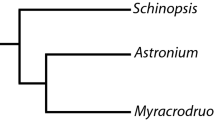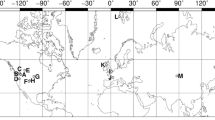Abstract
Fruits ofDipsacaceae are single-seeded, have bristle-shaped calyx segments and are tightly enclosed by four fused bracts forming an epicalyx. Comparative morphological and anatomical studies reveal a great diversity of epicalyx and calyx, often relevant to fruit dispersal. The present contribution deals with theScabiosa group of genera, the core of theScabioseae tribe. Most of its taxa develop a diaphragma from a meristem on the inside of the epicalyx. This diaphragma, together with the lower part of the epicalyx encloses the fruit proper, whereas the upper parts form a so-called “epi-diaphragma” (ed) and a ± hyaline corona. Differences of the epicalyx with respect to the size and position of the ed, elaboration of the corona, origin of pits (=foveoles) and other morphological and anatomical specializations can be demonstrated. Together with palynological and karyological data these new facts support an improved concept of relationships and systematics for the taxa studied:Scabiosa sect.Scabiosa and sect.Cyrtostemma are closely related and should be united to form the genusScabiosa s. str.;Pycnocomon can be maintained as an independent genus, sister toScabiosa sect.Trochocephalus which then has to be treated as a genus,Lomelosia. In contrast, the following genera have to be included inLomelosia:Tremastelma asLomelosia sect.Callistemma, andScabiosiopsis as part ofLomelosia sect.Lomelosia. Pseudoscabiosa deviates in so many features that it has to be excluded from the redefinedScabioseae s. str.
Similar content being viewed by others
References
Bobrov, E. G., 1957:Dipsacaceae. — In: Flora SSR14: 10–90. — Moscow, Leningrad: Akademii Nauk SSSR.
Burtt, B. L., 1950:Scabiosa leptopoda Boiss. (Dipsacaceae). — Hooker's Icon. Pl.35: tab. 3500.
Caputo, P., Cozzolino, S., 1994: A cladistic analysis ofDipsacaceae. — Pl. Syst. Evol.154: 41–61.
Colombo, P., Marceno, C., Princiotta, R., 1980: Numeri cromosomici per la Flora Italiana. — Boll. Soc. Bot. Ital.12: 173–180.
Devesa, J. A., 1984a: Revisión del generoScabiosa en la Peninsula Ibérica e Islas Baleares. — Lagascalia12: 143–212.
—, 1984b:Pseudoscabiosa, genero nuevo deDipsacaceae. — Lagascalia12: 213–221.
Diez, M. J., Devesa, J. A., 1981: Contributión al estudio palinológico del generoScabiosa L. (Dipsacaceae) en la Peninsula Ibérica y Baleares. — Bot. Macaronésica8–9: 129–146.
Erdtman, G., 1952: Pollen morphology and plant taxonomy. — Stockholm: Almquist & Wiksell.
Fernandez Casas, J., 1977: Recuentos cromosómicos en plantas vasculares españolas. — Saussurea8: 33–55.
Francini, E., Messeri, A., 1956: L' isola di Marettimo e la sua vegetazione. — Webbia11: 607–846.
Gerlach, D., 1984: Botanische Mikrotechnik. — Stuttgart: Thieme.
Greuter, W., Burdet, H. M., 1985:Dipsacaceae. — InGreuter, W., Raus, T., (Eds): Med-Checklist notulae, 11. — Willdenowia15: 71–77.
Hilger, H. H., Hoppe, M., 1984: Die Entwicklung des Außenkelchs vonScabiosa SektionenSclerostemma undTrochocephalus (Dipsacaceae). — Beitr. Biol. Pflanzen59: 55–73.
Jasiewicz, A., 1976:Scabiosa. — InTutin, T. G., Heywood, V. H., Burges, N. A., Valentine, D. H., Walters, S. M., Webb, D. A., (Eds): Flora Europaea4, pp. 68–74. — Cambridge: Cambridge University Press.
López Gonzáles, G., 1987:Pterocephalidium, un nuevo género ibérico de la familiaDipsacaceae. — Anales Jard. Bot. Madrid43: 245–252.
Matthews, V. H., 1972:Dipsacaceae. — InDavis, P. H., (Ed.): Flora of Turkey4, pp. 582–625. — Edinburgh: Edinburgh University Press.
Mayer, V., 1995: The epicalyx in fruits ofScabiosa andTremastelma (Dipsacaceae): anatomy and ecological significance. — Bot. Jahrb. Syst.117: 333–357.
-Ehrendorfer, F., 1999a: Fruit differentiation, palynology, and systematics inPterocephalus Adanson andPterocephalodes, gen. nov. (Dipsacaceae). — Bot. J. Linn. Soc. (in press).
- - 1999b: Fruit differentiation, palynology, and systematics inPterocephalidium, Pterothamnus, gen. nov., and the new tribePseudoscabioseae (Dipsacaceae). — Pl. Biol. (in press).
Mertens, F. K., Koch, W. D. J., 1823:Roehling, J. C., Deutschlands Flora, 3rd edn,I: 735-758.
Rechinger, K. H., 1989a:Scabiosa sect.Olivierianae, sect. nova (Dipsacaceae). — Willdenowia19: 137–151.
—, 1989b:Scabiosiopsis (Dipsacaceae), eine neue Gattung aus dem Iran. — Willdenowia19: 153–154.
—, 1991:Dipsacaceae. — InRechinger, K. H., (Ed.): Flora Iranica168, pp. 1–67.- Graz: Akademische Druck- und Verlagsanstalt.
Skvarla, J. J., Larson, D. A., 1965: An electron microscopic study of pollen in theCompositae with special reference to theAmbrosieae. — Grana Palynol.6: 210–269.
Szabo, Z., 1940: Monographia generisCephalaria. — Magyar Tud. Acad. Mat. Természett. Közlem.38(4): 1–352.
Verlaque, R., 1977: Validité et position systématique du genreTremastelma Raf. (Dipsacaceae). — Rev. Biol. Écol. Médit.4: 105–115.
—, 1981: Utilisation des caractères du pollen pour la réorganisation taxinomique de la famille desDipsacaceae. — Compt. Rend. Hebd. Séances Acad. Sci.293: 351–354.
—, 1984: A biosytematic and phylogenetic study of theDipsacaceae. — InGrant, W. F., (Ed.): Plant biosystematics, pp. 307–320. — Toronto: Academic Press Canada.
—, 1985a: Étude biosystématique et phylogénétique des Dipsacaceae. II. Caractères generaux desDipsacaceae. — Rev. Cytol. Biol. Végét. — Bot.8: 117–168.
—, 1985b: Étude biosystématique et phylogénétique desDipsacaceae. III. Tribus desKnautieae etDipsaceae. — Rev. Cytol. Biol. Végét. — Bot.8: 171–243.
—, 1986a: Étude biosystématique et phylogénétique desDipsacaceae. IV. Tribu desScabioseae (phylum No 1, 2, 3). — Rev. Cytol. Biol. Végét. — Bot.9: 5–72.
—, 1986b: Étude biosystématique et phylogénétique desDipsacaceae. V. Tribu desScabioseae (phylum No 4) et conclusion. — Rev. Cytol. Biol. Végét. — Bot.9: 97–176.
Author information
Authors and Affiliations
Rights and permissions
About this article
Cite this article
Mayer, V., Ehrendorfer, F. Fruit differentiation, palynology, and systematics in theScabiosa group of genera andPseudoscabiosa (Dipsacaceae). Pl Syst Evol 216, 135–166 (1999). https://doi.org/10.1007/BF00985103
Received:
Revised:
Accepted:
Issue Date:
DOI: https://doi.org/10.1007/BF00985103




